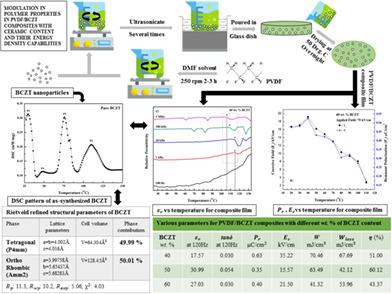当前位置:
X-MOL 学术
›
Polym. Compos.
›
论文详情
Our official English website, www.x-mol.net, welcomes your
feedback! (Note: you will need to create a separate account there.)
Modulation in polymer properties in PVDF/BCZT composites with ceramic content and their energy density capabilities
Polymer Composites ( IF 4.8 ) Pub Date : 2020-09-15 , DOI: 10.1002/pc.25795 Tarun Garg 1, 2, 3 , Venkateswarlu Annapureddy 4 , K. C. Sekhar 5 , Dae‐Yong Jeong 6 , Navneet Dabra 7 , Jasbir S. Hundal 2
Polymer Composites ( IF 4.8 ) Pub Date : 2020-09-15 , DOI: 10.1002/pc.25795 Tarun Garg 1, 2, 3 , Venkateswarlu Annapureddy 4 , K. C. Sekhar 5 , Dae‐Yong Jeong 6 , Navneet Dabra 7 , Jasbir S. Hundal 2
Affiliation

|
The lead‐free 0.5((Ba0.7Ca0.3)TiO3)‐0.5(Ba(Zr0.2Ti0.8))O3(BCZT) piezoceramics were synthesized using sol‐gel method. The Rietveld analysis of X‐ray diffraction (XRD) data and differential scanning calorimetry (DSC) studies of as‐synthesized BCZT powder suggests the co‐existence of ferroelectric orthorhombic (O) and tetragonal (T) phases at room temperature (RT). The value of curie temperature (TT‐C) as depicted from DSC and dielectric studies was found to be ≈ 110°C. The BCZT ceramic particles were dispersed in the polyvinylidene fluoride (PVDF) matrix, an electroactive polymer with great ferro/piezoelectric response in its distinct β and γ phases, to form ferroelectric ceramic‐polymer composites for their applications in flexible energy storage capacitors. The present work reports the Fourier‐transform infrared spectroscopy (FTIR), XRD, dielectric, ferroelectric, and energy density properties of PVDF/BCZT composite films having different wt% of BCZT content fabricated by the solution‐cast technique. The FTIR and XRD studies depict the γ‐PVDF and pure BCZT phases in composite films. The dielectric studies estimated the relative permittivity (εr) of a composite film with 50 wt% of BCZT content to be ≈ 31 (at 120 Hz) which was about three times as compared with that of pure PVDF. The dielectric loss (tan δ) was maximum ≈ 0.15 (at 120 Hz) for 50 wt% BCZT composition. The ferroelectric studies and energy storage calculations showed that the value of remnant polarization (Pr), coercive field (Ec) and energy storage density (W) attain the maximum value of 0.63 μC/cm2, 35.22 kV/cm, and 70.46 mJ/cm3, respectively for the film sample having 40 wt% BCZT content. The maximum energy storage efficiency, η (%) is calculated to be ≈ 60 for 50 wt% BCZT composition. The results indicated that the incorporation of BCZT particles in the PVDF matrix improved the overall polarization (polar and interfacial) which enhance the electric properties of composite films. The ferroelectric studies with temperature revealed the PVDF/BCZT composition‐dependent polymer or ceramic dominance in the behavior of composite films. With the maximum value of relative permittivity (εr) and energy storage efficiency (η), the PVDF/BCZT composition with 50 wt% of BCZT content has been optimized for applications in flexible energy storage capacitors.
中文翻译:

具有陶瓷含量及其能量密度能力的PVDF / BCZT复合材料中聚合物性能的调节
采用溶胶-凝胶法合成了无铅0.5((Ba 0.7 Ca 0.3)TiO 3)-0.5(Ba(Zr 0.2 Ti 0.8))O 3(BCZT)压电陶瓷。合成BCZT粉末的X射线衍射(XRD)数据和差示扫描量热法(DSC)研究的Rietveld分析表明,室温(RT)时铁电正交相(O)和四方相(T)共存。居里温度值(T T‐C如DSC所示,介电研究发现温度约为110°C。将BCZT陶瓷颗粒分散在聚偏二氟乙烯(PVDF)基质中,该聚偏二氟乙烯(PVDF)是一种在其不同的β和γ相中具有出色的铁电/压电响应的电活性聚合物,形成了铁电陶瓷聚合物复合材料,可用于柔性储能电容器中。本工作报道了通过溶液流延技术制备的具有不同重量百分比的BCZT含量的PVDF / BCZT复合膜的傅里叶变换红外光谱(FTIR),XRD,介电,铁电和能量密度特性。FTIR和XRD研究描述了复合膜中的γ-PVDF相和纯BCZT相。电介质的研究估计的相对介电常数(ε ř)的复合膜,其中BCZT含量为50 wt%时约为≈31(在120 Hz时),是纯PVDF的三倍。介电损耗(tanδ δ)为50%(重量)组合物BCZT最大≈0.15(以120Hz)。铁电体研究和能量存储计算表明,剩余极化的值(P - [R ),矫顽场(Ë Ç)和能量存储密度(w ^)达到0.63μC/厘米的最大值2,35.22千伏/厘米,和70.46对于具有40重量%BCZT含量的膜样品,分别为mJ / cm 3。最大储能效率η对于50 wt%的BCZT组成,(%)计算得出约为60。结果表明,将BCZT颗粒掺入PVDF基质中可改善整体极化(极性和界面),从而增强复合膜的电性能。在温度下进行的铁电研究表明,PVDF / BCZT成分取决于聚合物或陶瓷在复合膜行为中的优势。用相对介电常数(的最大值ε - [R )和能量存储效率(η),其中的内容BCZT 50%(重量)的PVDF / BCZT组合物已被用于灵活的能量存储电容器应用进行了优化。
更新日期:2020-09-15
中文翻译:

具有陶瓷含量及其能量密度能力的PVDF / BCZT复合材料中聚合物性能的调节
采用溶胶-凝胶法合成了无铅0.5((Ba 0.7 Ca 0.3)TiO 3)-0.5(Ba(Zr 0.2 Ti 0.8))O 3(BCZT)压电陶瓷。合成BCZT粉末的X射线衍射(XRD)数据和差示扫描量热法(DSC)研究的Rietveld分析表明,室温(RT)时铁电正交相(O)和四方相(T)共存。居里温度值(T T‐C如DSC所示,介电研究发现温度约为110°C。将BCZT陶瓷颗粒分散在聚偏二氟乙烯(PVDF)基质中,该聚偏二氟乙烯(PVDF)是一种在其不同的β和γ相中具有出色的铁电/压电响应的电活性聚合物,形成了铁电陶瓷聚合物复合材料,可用于柔性储能电容器中。本工作报道了通过溶液流延技术制备的具有不同重量百分比的BCZT含量的PVDF / BCZT复合膜的傅里叶变换红外光谱(FTIR),XRD,介电,铁电和能量密度特性。FTIR和XRD研究描述了复合膜中的γ-PVDF相和纯BCZT相。电介质的研究估计的相对介电常数(ε ř)的复合膜,其中BCZT含量为50 wt%时约为≈31(在120 Hz时),是纯PVDF的三倍。介电损耗(tanδ δ)为50%(重量)组合物BCZT最大≈0.15(以120Hz)。铁电体研究和能量存储计算表明,剩余极化的值(P - [R ),矫顽场(Ë Ç)和能量存储密度(w ^)达到0.63μC/厘米的最大值2,35.22千伏/厘米,和70.46对于具有40重量%BCZT含量的膜样品,分别为mJ / cm 3。最大储能效率η对于50 wt%的BCZT组成,(%)计算得出约为60。结果表明,将BCZT颗粒掺入PVDF基质中可改善整体极化(极性和界面),从而增强复合膜的电性能。在温度下进行的铁电研究表明,PVDF / BCZT成分取决于聚合物或陶瓷在复合膜行为中的优势。用相对介电常数(的最大值ε - [R )和能量存储效率(η),其中的内容BCZT 50%(重量)的PVDF / BCZT组合物已被用于灵活的能量存储电容器应用进行了优化。











































 京公网安备 11010802027423号
京公网安备 11010802027423号